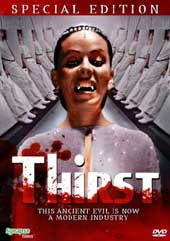 THIRST
(1979)
THIRST
(1979)Director: Rod Hardy
Synapse Films
 THIRST
(1979)
THIRST
(1979)1979 was a pivotal year for vampire films, at least in the amount of titles unleashed upon the public. Klaus Kinksi starred in Werner Herzog’s NOSFERATU THE VAMPYRE, while Broadway star Frank Langella headlined John Badham’s much hyped version of DRACULA. AIP’s Drac spoof LOVE AT FIRST BITE with George Hamilton was a hit at the box office, John Carradine played the aging Count in the disco comedy NOCTURNA, and SALEM’S NOT, an adaptation of a popular Stephen King novel, was a highly rated television event. And amidst all these (and a few other fangy efforts) was THIRST, a modest Australian production which offered the most original take on vampire lore in quite a while.
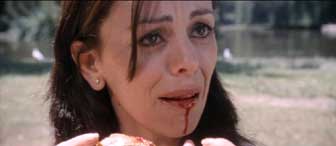
Attractive business woman Kate Davis (Chantal Contouri) is abducted by a sophisticated cult of vampires, interested in her as a subject since she is a direct descendant of the notorious Countess Elizabeth Bathory. The organized cult is headed by Ms. Cameron (Shirley Cameron), Mr. Hodge (Max Phipps, THE ROAD WARRIOR), Dr. Gauss (Henry Silva) and Dr. Fraser (David Hemmings). Kate is brought to an experimental clinic/farm where humans are drained to provide manufactured, bottled blood, and it’s her captors’ intentions to condition her to fully enjoy the experience of slurping the red stuff, something she obviously abhors. Through chemical treatment and hi-tech gadgetry, the strong-willed Kate’s psyche is invaded with constant outlandish occurrences, all which conclude with the intake of blood, brought upon in various unsuspicious manners.
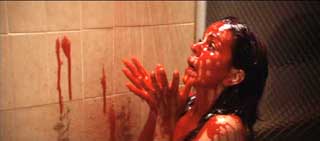 THIRST
may be thinly plotted and even void of dialog for some stretches, but its central
idea presents a solid, fresh approach to vampirism. Here, vampirism is an industry
controlled by a group of civilized intellectuals who are devious enough to get
away with the abusive mind control and human blood letting needed to run such
an operation. The plight of Kate Davis moves about in a non-linear pattern,
and the character as well as the viewer is not always certain what is real and
what isn’t, and this ambiguous descent into madness is the focal point
of the film. Whether it be getting an unsuspecting mouthful of blood from a
chicken leg or mug of hot cocoa, or getting doused with it through the shower
drain (a great bit which modernizes Bathory’s blood bathes), these nightmare
sequences provide some terrric imagery, handsomely shot in Panavision.
THIRST
may be thinly plotted and even void of dialog for some stretches, but its central
idea presents a solid, fresh approach to vampirism. Here, vampirism is an industry
controlled by a group of civilized intellectuals who are devious enough to get
away with the abusive mind control and human blood letting needed to run such
an operation. The plight of Kate Davis moves about in a non-linear pattern,
and the character as well as the viewer is not always certain what is real and
what isn’t, and this ambiguous descent into madness is the focal point
of the film. Whether it be getting an unsuspecting mouthful of blood from a
chicken leg or mug of hot cocoa, or getting doused with it through the shower
drain (a great bit which modernizes Bathory’s blood bathes), these nightmare
sequences provide some terrric imagery, handsomely shot in Panavision.
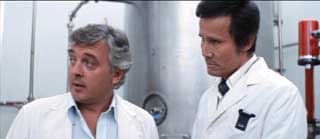
Other interesting scenes to this new age brand of vampirism include a group of assorted typical-looking tourists (themselves vampires) being guided through a room where zombified hordes are “milked” for their blood sources, and Kate’s ceremonial initiation, where tuxedoed onlookers anxiously await her to snap in the silver canines and strike the jugulars of the nude male offering on an altar. Chantal Contouri is very good as the victimized heroine, displaying a great range of expression, especially when her often upsetting situations don’t call for dialog, and though some of the other characters are not properly fleshed out, the acting is solid overall, even if the film at times is meant to be tongue-in-cheek. The most familiar faces here are the always dependable, late David Hemmings (DEEP RED) as a more seemingly sympathizing member of the cult, and tough guy Henry Silva, who at times looks somewhat out of place, despite being a welcomed addition to the cast. Robert Thompson, the curly-haired star of PATRICK, makes an appearance, as does Yvette Rees (who should have been a 1960s cult star after WITCHCRAFT and CURSE OF THE FLY) who shows up briefly as a nurse.
 In
2003, Elite Entertainment released THIRST (now discontinued) with an atrocious
cover that resembled the backing card for a pair of cheap plastic vampire fans,
an outward attribute that probably hindered potential buyers. With much more
appealing cover art, Synapse is re-releasing the film, carrying over all the
extras as well as the excellent transfer. Presented in its original 2.35:1 aspect
ratio with anamorphic enhancement, THIRST has vibrant colors and sharp detail,
with only some minor, fleeting speckling and film dirt – it’s hard
to believe that the transfer was done from a well-stored 35mm print, rather
than the film’s original elements, because it looks that good. The English
Dolby Digital mono track is strong, with dialog always being understandable,
and sound effects and music also coming through nice and clear. As a bonus,
the score by the legendary Brian May (MAD MAX) can be fully isolated on a separate
track.
In
2003, Elite Entertainment released THIRST (now discontinued) with an atrocious
cover that resembled the backing card for a pair of cheap plastic vampire fans,
an outward attribute that probably hindered potential buyers. With much more
appealing cover art, Synapse is re-releasing the film, carrying over all the
extras as well as the excellent transfer. Presented in its original 2.35:1 aspect
ratio with anamorphic enhancement, THIRST has vibrant colors and sharp detail,
with only some minor, fleeting speckling and film dirt – it’s hard
to believe that the transfer was done from a well-stored 35mm print, rather
than the film’s original elements, because it looks that good. The English
Dolby Digital mono track is strong, with dialog always being understandable,
and sound effects and music also coming through nice and clear. As a bonus,
the score by the legendary Brian May (MAD MAX) can be fully isolated on a separate
track.
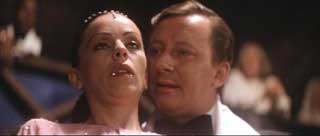 A
commentary track (carried over from the 2003 Elite release) is included with
director Rod Hardy and producer Antony Ginnane, and is a pleasure to listen
to. The two gentlemen are well spoken and thorough, and there’s absolutely
no need for a moderator here as they reminisce about their attempts to make
the film look “international” on its limited budget of 750,000 Australian
dollars. Everything is touched upon from the cast, locations, sets, etc, and
they clearly illustrate what the Aussie film business was like in those very
prolific days of the late 1970s. Rounding out the extras on this recommended
disc are a photo gallery, filmographies, a theatrical trailer and three different
TV spots. (George
R. Reis)
A
commentary track (carried over from the 2003 Elite release) is included with
director Rod Hardy and producer Antony Ginnane, and is a pleasure to listen
to. The two gentlemen are well spoken and thorough, and there’s absolutely
no need for a moderator here as they reminisce about their attempts to make
the film look “international” on its limited budget of 750,000 Australian
dollars. Everything is touched upon from the cast, locations, sets, etc, and
they clearly illustrate what the Aussie film business was like in those very
prolific days of the late 1970s. Rounding out the extras on this recommended
disc are a photo gallery, filmographies, a theatrical trailer and three different
TV spots. (George
R. Reis)